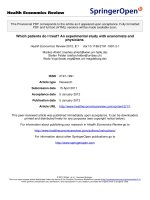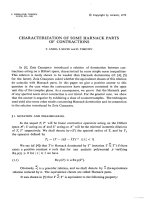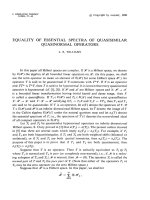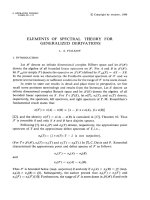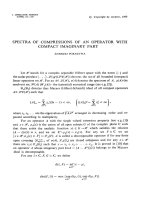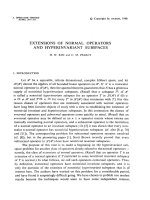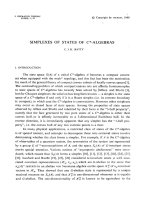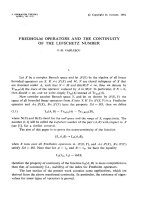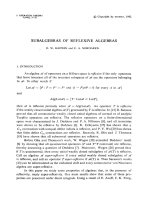Báo cáo toán học: "Methods of preventing vinorelbine-induced phlebitis: an experimental study in rabbits" pps
Bạn đang xem bản rút gọn của tài liệu. Xem và tải ngay bản đầy đủ của tài liệu tại đây (427.43 KB, 6 trang )
Int. J. Med. Sci. 2008, 5
218
International Journal of Medical Sciences
ISSN 1449-1907 www.medsci.org 2008 5(4):218-223
© Ivyspring International Publisher. All rights reserved
Research Paper
Methods of preventing vinorelbine-induced phlebitis: an experimental
study in rabbits
Emiko Kohno
1
, Saori Murase
2
, Mayumi Nishikata
2
, Noboru Okamura
2
, Sumio Matzno
2
, Takashi Kuwahara
3
,
and Kenji Matsuyama
4
1. Department of Hospital Pharmacy, Kansai Medical University Takii Hospital, 10-15 Fumizono-cho, Moriguchi, Osaka
570-8507, Japan
2. Department of Clinical Pharmacy, School of Pharmaceutical Sciences, Mukogawa Women’s University, 11-68 Kos-
hien-Kyuban-cho, Nishinomiya, Hyogo 663-8179, Japan
3. Research Fellow, Drug Safety Research Institute, Otsuka Pharmaceutical Factory, Inc., 115 Muya-cho, Naruto Tokushima,
772-8601, Japan
4. Department of Clinical Pharmacy, Faculty of Pharmacy, Keio University, 1-5-30 Shibakoen, Minato-ku, Tokyo 105-8512,
Japan
Correspondence to: Emiko Kohno, MS, Vice Director, Department of Pharmacy, Kansai Medical University Takii Hospital, 10-15
Fumizono-cho, Moriguchi, Osaka 570-8507, Japan. Tel: +81-6-6992-1001, Fax: +81-6-6995-5425, E-mail:
Received: 2008.05.09; Accepted: 2008.07.21; Published: 2008.07.22
Purpose: In order to identify methods for preventing phlebitis caused by intravenous administration of vi-
norelbine (VNR), we established a procedure for estimating the severity of phlebitis in an animal model.
Methods: Four different factors (administration rate, dilution, flushing, and infusion of fat emulsion) were
evaluated for alleviation of phlebitis caused by VNR infusion. VNR was diluted with normal saline to prepare test
solutions with concentrations of 0.6 mg/mL or 0.3 mg/mL for infusion into the auricular veins of rabbits. Two
days after VNR infusion, the veins were subjected to histopathological examination.
Results: VNR did not cause obvious loss of venous endothelial cells, the most sensitive and common feature of
phlebitis, but VNR infusion led to inflammatory cell infiltration, edema, and epidermal degeneration.
Tissue damage was significantly decreased by shortening the administration time and by diluting the VNR solu-
tion for infusion from 0.6 mg/mL to 0.3 mg/mL. However, there was no effect of flushing with normal saline after
VNR infusion, while treatment with fat emulsion before and after VNR infusion only had a minimal effect.
Conclusion: Rapid infusion and dilution are effective methods of reducing phlebitis caused by the infusion of
VNR, but the efficacy of flushing with normal saline or infusion of fat emulsion was not confirmed.
Key words: vinorelbine, phlebitis, rabbit ear vein, infusion rate, solution concentration
1. Introduction
Vinorelbine (VNR) is a semi-synthetic vinca al-
kaloid derived from vinblastine that is used to treat
non-small cell lung cancer (NSCLC) and breast cancer.
For the treatment of NSCLC, VNR is administered at a
dose of 20 to 25 mg/m
2
alone [1] or in combination
with cisplatin [2] or gemcitabine [3, 4]. VNR is also
administered at a dose of 25 mg/m
2
alone or com-
bined with cisplatin or trastuzumab in patients with
inoperable, advanced, and recurrent breast cancer,
who have previously received anthracyclines and
taxanes [5, 6]. The main adverse effects of VNR are
granulocytopenia, leucopenia, and thrombocytopenia,
with granulocytopenia being the primary
dose-limiting toxicity. Phlebitis is another problematic
adverse effect of intravenous VNR, and the incidence
of phlebitis (local venous toxicity) after a 6-min infu-
sion of VNR has been reported as 16-33% [7-9]. Phlebi-
tis limits the continuation of chemotherapy by de-
creasing patient motivation and compliance.
VNR has been reported to cause venous discol-
oration and chemical phlebitis proximal to the site of
injection, as well as localized rashes and urticaria,
blistering, and skin sloughing [10]. It is a vesicant and
venous irritant like other vinca alkaloids. Factors that
influence the development of phlebitis include the
quality of the vein selected, the size and type of cathe-
ter used, the duration of infusion, and the pH and
Int. J. Med. Sci. 2008, 5
219
osmolality of the drug solution. The Japanese package
insert for VNR recommends dilution with 50 mL of
normal saline or 5% glucose and administration over
less than 10 min, followed by flushing of the vein but
the effectiveness of this protocol has not been evalu-
ated.
The purpose of the present study was to establish
an experimental method for estimating the severity of
phlebitis caused by VNR in rabbits, and then to test
various methods that have been reported for prevent-
ing phlebitis caused by intravenous VNR, including
more rapid administration, dilution, flushing, and in-
fusion of fat emulsion [11-13].
2. Materials and Methods
Animals
Male Japanese white rabbits (Std; JW, Japan SLC,
Inc., Shizuoka, Japan) weighing between 2.3 and 3.5
kg were housed in individual cages in an animal room
maintained at 23 ± 3°C and 55 ± 10 % relative humid-
ity with ventilation 13-16 times/hr and a 12-hr
light-dark cycle. The rabbits were allowed free access
to diet and water, except during treatment. This study
was approved by the Committee on Animal Experi-
ments of Mukogawa Women’s University.
Drugs
Navelbine
®
Injection (VNR) was kindly provided
by Kyowa Hakko Kogyo Co. (Tokyo, Japan). A 1- mL
vial of Navelbine
®
Injection was diluted with normal
saline (Otsuka Normal Saline; Otsuka Pharmaceutical
Factory, Inc., Tokushima, Japan) to provide either a 0.6
mg/mL or 0.3 mg/mL solution of VNR. In addition,
normal saline and 20% fat emulsion (Intralipos
®
20%:
Otsuka Pharmaceutical Factory, Inc.) were tested to
examine their influence on VNR-induced phlebitis.
Experimental procedure
Test solutions were infused through a plastic
catheter (Surflo, 24 gauge, outer diameter of 0.67 mm
and length of 19 mm; Terumo Co., Tokyo, Japan) into
an ear vein using a peristaltic pump (Minipuls 2, Gil-
son, Inc., WI, USA) (Figure 1). Veins in both ears were
employed to compare different infusion conditions.
The dose of VNR was set at 1.5 mg/kg in all experi-
ments. Rabbits were killed by an overdose of sodium
pentobarbital (Nembutal
®
, Dainippon Sumitomo
Pharmaceutical Co., Osaka, Japan) at 2 days after infu-
sion. Two samples of the ear vein were obtained, in-
cluding the region 3-10 mm from the catheter tip
(proximal region) and the region 20-30 mm from the
catheter tip (distal region) (Figure 1). These were fixed
in phosphate-buffered saline containing 10% formalin.
Then cross-sections of the ear vein were prepared and
stained with hematoxylin and eosin (HE). Histopa-
thological examination was performed blindly, with
the findings being graded according to the criteria
shown in Table 1. These criteria were based on those
of Kuwahara [14], with the addition of epidermal de-
generation.
Figure 1. Sites of histopathological examination. Two regions
of the ear vein, one located 3-10 mm from the catheter tip
(proximal region) and the other located 20-30 mm (distal re-
gion) from it, were sampled at 2 days after infusion.
Table 1 Criteria for histopathological examination
Influence of the infusion rate
In 8 rabbits, a 0.6 mg/mL solution of VNR was
infused into one ear vein for 30 min at 5 mL/kg/hr as
a control, and the same solution was infused into the
contralateral ear vein for 10 min at 15 mL/kg/hr
(3-fold faster). The concentration of VNR was selected
to be similar to the clinical concentration range. Before
Int. J. Med. Sci. 2008, 5
220
and after VNR infusion, normal saline was infused
into both veins for 24
min at 5 mL/kg/hr.
Influence of the concentration
In 8 rabbits, a 0.6 mg/mL solution of VNR was
infused into one ear vein for 30 min at 5 mL/kg/hr as
a control, and a 0.3 mg/mL solution of VNR was in-
fused into the contralateral ear vein for 30 min at 10
mL/kg/hr.
Effect of flushing with normal saline
A 0.6 mg/mL solution of VNR was infused for 30
min at 5 mL/kg/hr into the right and left ear veins of
8 rabbits. In one ear vein, infusion of VNR was fol-
lowed by flushing with 5 mL of normal saline for 1
min, while the other ear vein was not flushed as a
control.
Effect of 20% fat emulsion
A 0.6 mg/mL solution of VNR was infused for 30
min at 5 mL/kg/hr into the right and left ear veins of
8 rabbits. In one ear vein, 20% fat emulsion (Intrali-
pos
®
) was infused for 24 min at 5 mL/kg/hr both be-
fore and after VNR infusion. In the other ear vein,
normal saline was infused in the same manner as a
control.
Statistical analysis
The grade of each histopathological finding was
compared between groups by the Wilcoxon rank sum
test and p<0.05 was considered to indicate a signifi-
cant difference.
3. Results
Influence of the infusion rate
Figure 2 shows a representative photomicro-
graph of a normal vein without exposure to VNR and
Table 2 summarizes the histopathological findings
after infusion of VNR at a normal or rapid rate. Infu-
sion of a 0.6 mg/mL solution of VNR for 30 min at 5
mL/kg/hr (control) only caused slight loss of venous
endothelial cells (Grade 1) in the distal region of the
vein in 1 of 8 animals. In addition, there was inflam-
matory cell infiltration (Grades 2-3) in the proximal
and distal regions of the vein in 5 animals each, edema
(Grades 1-2) of the proximal vein region in 3 animals
and the distal region in 5 animals, and epidermal de-
generation (Grades 1-3) at both the proximal and dis-
tal regions in all 8 animals (Figure 3). After infusion of
the same solution 3 times more rapidly (10 min, 15
mL/kg/hr), there was inflammatory cell infiltration
(Grades 1-2) at the proximal vein region in 4 out of 8
animals and at the distal region in 3 animals, but
edema (Grade 2) was only found in the proximal re-
gion of 1 animal. Epidermal degeneration (Grades 1-3)
still occurred at both the proximal and distal regions
in 7 out of 8 animals. Edema of the distal region was
significantly less severe in the rapid infusion group
compared with the control infusion group (p<0.05).
Figure 2. Typical photomicrographs of an untreated ear vein.
Figure 3. Typical photomicrographs of an ear vein after VNR
infusion. A 0.6-mg/mL solution of VNR was infused into an ear
vein for 30 min at 5 mL/kg/hr, and the vein was subjected to
pathological examination after 2 days.
Int. J. Med. Sci. 2008, 5
221
Table 2 Influence of the infusion rate on histopathological changes at 2 days after VNR infusion. In 8 rabbits, a 0.6-mg/mL solution
of VNR was infused into one ear vein for 30 min at 5 mL/kg/hr as a control, and the same solution was also infused into the con-
tralateral ear vein for 10 min at 15 mL/kg/hr (3-fold faster).
Region Infusion rate Loss of venous
endothelial cells
p
value
Inflammatory
cell infiltration
p
value
Edema p value Epidermal de-
generation
p
value
Grade 0 1 2 3 0 1 2 3 0 1 2 3 0 1 2 3
Control 8 0 0 0 3 0 2 3 5 2 1 0 0 2 3 3 Proximal
Rapid 8 0 0 0
N.S.
4 3 1 0
N.S.
7 0 1 0
N.S.
1 2 4 1
N.S.
Control 7 1 0 0 3 0 3 2 3 3 2 0 0 3 2 3 Distal
Rapid 8 0 0 0
N.S.
5 1 2 0
N.S.
8 0 0 0
<0.05
1 3 4 0
N.S.
Numbers in the table represent the number of observations. N.S.; not significant
Influence of the concentration
The results of histopathological examination are
shown in Table 3. Infusion of a 0.6 mg/mL solution of
VNR (control solution) caused slight loss of venous
endothelial cells (Grade 1) at the proximal vein region
in 2 out of 8 animals and at the distal region in 3 ani-
mals, as well as inflammatory cell infiltration (Grades
1-2) in the proximal region of all 8 animals and the
distal region of 7 animals. In addition, edema (Grades
1-3) was noted at the proximal region in 4 animals and
at the distal region in 5 animals, while epidermal de-
generation (Grades 2-3) was seen at both the proximal
and distal regions in all 8 animals. The 0.3 mg/mL
solution of VNR (diluted solution) caused slight loss
of venous endothelial cells (Grade 1) at the proximal
vein region in 3 out of 8 animals and at the distal re-
gion in 2 animals, inflammatory cell infiltration
(Grades 1-3) in the proximal and distal regions of 6
animals, edema (Grade 2) at the proximal region in 1
animal and the distal region in 3 animals, and epi-
dermal degeneration (Grades 1-3) at both the proximal
and distal regions in all 8 animals. Significantly less
severe epidermal degeneration at the proximal region
was noted after infusion of the diluted solution
(p<0.05).
Effect of flushing with normal saline
Table 4 shows a comparison of the histopa-
thological grades between VNR infusion with and
without a normal saline flush. Flushing with normal
saline led to a slight reduction in the loss of venous
endothelial cells, but the improvement was not statis-
tically significant.
Effect of 20% fat emulsion
The results of histopathological examinations are
shown in Table 5. No significant differences were ob-
served after infusion of fat emulsion.
Table 3 Influence of the concentration on histopathological changes at 2 days after VNR infusion. In 8 rabbits, a 0.6-mg/mL solution
of VNR was infused into one ear vein for 30 min at 5 mL/kg/hr as a control, and a 0.3-mg/mL solution of VNR was infused into the
contralateral ear vein for 30 min at 10 mL/kg/hr.
Region Solution concentration Loss of venous
endothelial cells
p
value
Inflammatory
cell infiltration
p
value
Edema p
value
Epidermal de-
generation
p value
Grade 0 1 2 3 0 1 2 3 0 1 2 3 0 1 2 3
Control 6 2 0 0 0 2 6 0 4 2 2 0 0 0 5 3 Proximal
Dilution 5 3 0 0
N.S.
2 3 3 0
N.S.
7 0 1 0
N.S.
0 2 6 0
<0.05
Control 5 3 0 0 1 1 6 0 3 1 3 1 0 0 5 3 Distal
Dilution 6 2 0 0
N.S.
2 3 2 1
N.S.
5 0 3 0
N.S.
0 2 5 1
N.S.
Numbers in the table represent the number of observations. N.S.; not significant
Table 4 Effect of flushing with normal saline on histopathological changes at 2 days after VNR infusion. A 0.6-mg/mL solution of
VNR was infused for 30 min at 5 mL/kg/hr into the right and left ear veins of 8 rabbits. In one ear vein, VNR infusion was followed
by flushing with normal saline (5 mL over 1 min), while the other ear vein was not flushed as a control.
Region Saline flush Loss of venous
endothelial cells
p
value
Inflammatory
cell infiltration
p
value
Edema p
value
Epidermal de-
generation
p
value
Grade 0 1 2 3 0 1 2 3 0 1 2 3 0 1 2 3
Without flush 4 4 0 0 1 3 4 0 1 6 1 0 0 0 4 4 Proximal
With flush 7 1 0 0
N.S.
1 0 5 2
N.S.
3 1 3 1
N.S.
0 0 4 4
N.S.
Without flush 6 2 0 0 1 1 6 0 2 2 4 0 0 0 6 2 Distal
With flush 7 1 0 0
N.S.
2 1 4 1
N.S.
3 1 3 1
N.S.
0 1 4 3
N.S.
Numbers in the table represent the number of observations. N.S.; not significant
Int. J. Med. Sci. 2008, 5
222
Table 5 Effect of fat emulsion on histopathological changes at 2 days after VNR infusion. A 0.6-mg/mL solution of VNR was
infused for 30 min at 5 mL/kg/hr into the right and left ear veins of 8 rabbits. In one ear vein, 20% fat emulsion (Intralipos
®
) was
infused for 24 min at 5 mL/kg/hr before and after VNR infusion. In the other ear vein, normal saline was infused in the same manner
as a control.
Region Fat emulsion treatment Loss of venous
endothelial cells
p
value
Inflammatory
cell infiltration
p
value
Edema p
value
Epidermal de-
generation
p
value
Grade 0 1 2 3 0 1 2 3 0 1 2 3 0 1 2 3
Without treatment 8 0 0 0 2 0 4 2 4 3 1 0 0 0 7 1 Proximal
With treatment 8 0 0 0
N.S.
1 4 3 0
N.S.
4 3 1 0
N.S.
0 2 4 2
N.S.
Without treatment 8 0 0 0 1 3 3 1 4 2 2 0 0 1 6 1 Distal
With treatment 8 0 0 0
N.S.
2 3 3 0
N.S.
3 4 1 0
N.S.
0 3 5 0
N.S.
Numbers in the table represent the number of observations. N.S.; not significant
4. Discussion
VNR is widely used to treat solid tumors such as
NSCLC [1-4] and breast cancer [5, 6]. Phlebitis due to
infusion of VNR is the one of the complications that
limits treatment. Various methods of avoiding such
phlebitis have been reported [11-13], but none are
completely effective. It was reported that rapid infu-
sion and flushing are effective for reducing phlebitis
in the clinical setting [7], so an infusion rate of less
than 5 minutes [15] but more than 1 minute has been
recommended for VNR [7]. To clarify the most effi-
cient methods of preventing VNR induced phlebitis,
we evaluated the effects of the VNR infusion rate,
VNR concentration, saline flushing, and infusion of fat
emulsion on phlebitis in a rabbit auricular vein model.
There is little histopathological information
about the effects of VNR infusion in animals and hu-
mans. However, infusion into the auricular vein in
rabbits has been often used to investigate phlebitis
[16-18]. In addition, we have already investigated the
influence of osmolarity on phlebitis in this model [19],
and the results were consistent with clinical data re-
ported by Kerin and colleagues [20]. Thus, it was
thought that this model could be used to investigate
phlebitis caused by the infusion of VNR.
Infusion of VNR did not cause marked loss of
venous endothelial cells, which is considered to be the
most sensitive and common feature of phlebitis due to
experimental infusion [16], but it caused epidermal
degeneration in almost all cases (Table 3). These find-
ings suggested that VNR has different characteristics
from common chemical irritants that induce phlebitis.
Although the reason for this difference is unclear, it
seems likely that part of a dose of VNR infused into a
peripheral vein escapes into the perivascular tissue
and reaches the epidermis, where it causes the
changes of “epidermal degeneration.”
It has been reported that infusion of VNR over
6-10 minutes decreases the incidence of phlebitis
compared with infusion over 20-30 minutes [9], and
the frequency of phlebitis is even lower decreased
with bolus administration over 1 min followed by
flushing with normal saline [7]. We also found that
tissue damage was decreased by a shorter infusion
time, suggesting that this rabbit model was appropri-
ate to investigate VNR-related phlebitis. We con-
firmed that the infusion rate had an important influ-
ence on VNR-induced phlebitis.
It has been suggested that dilution is effective for
reducing phlebitis caused by various agents in hu-
mans and animals [21, 22]. In this study, we confirmed
that dilution could alleviate VNR-induced phlebitis,
suggesting that the drug concentration could one of
the important factors provoking its occurrence. Thus,
it is probably better to dilute VNR before infusion.
Flushing with normal saline after VNR infusion and
infusion of fat emulsion both before and after VNR
were also investigated in this study. Although flush-
ing with normal saline led to a slight reduction in the
loss of venous endothelial cells (Table 4), the effect
was not significant. The manufacturer of VNR rec-
ommends flushing with >75-125 mL of fluid after in-
fusion [23], but there is little information about the
efficacy of flushing. We did not confirm its usefulness
in this study, so further investigation is needed.
Matsusune et al. reported that infusion of fat
emulsion reduced phlebitis in patients receiving pe-
ripheral parenteral nutrition, and suggested that it had
a protective effect on the peripheral veins [24]. How-
ever, we did not observe any effect of fat emulsion on
phlebitis caused by VNR, suggesting that its infusion
might provide insufficient protection.
Phlebitis is considered to be associated with the
mechanism of action of VNR. Rapid infusion and di-
lution with normal saline were both effective for re-
ducing phlebitis after VNR infusion. That is, the de-
velopment of phlebitis was related to the amount of
contact (infusion duration and solution concentration)
between VNR and the vascular endothelium. Since
greater blood flow allows a more rapid rate of ad-
ministration and more dilution VNR, choosing a large
vessel with rapid blood flow may also be effective for
preventing phlebitis caused by VNR infusion.
Int. J. Med. Sci. 2008, 5
223
In conclusion, our results suggest that rapid ad-
ministration and dilution of the infusion solution are
effective methods for preventing VNR-induced phle-
bitis. Choosing a large vein might also have a preven-
tive effect, but further studies are needed for confir-
mation.
Conflict of Interest
The authors declare that no conflicts of interest
exist.
References
1. Gridelli S. The ELVIS trial: a phase III study of single-agent
vinorelbine as first-line treatment in elderly patients with
advanced non-small cell lung cancer. Elderly Lung Cancer
Vinorelbine Italian Study. Oncologist. 2001; 6:4-7.
2. Kelly K, Crowley J, Bunn PA Jr, et al. Randomized phase III trial
of paclitaxel plus carboplatin versus vinorelbine plus cisplatin
in the treatment of patients with advanced non-small-cell lung
cancer: a Southwest Oncology Group trial. J Clin Oncol. 2001;
19:3210-3218.
3. Gridelli C, Perrone F, Gallo C, et al. Chemotherapy for elderly
patients with advanced non-small-cell lung cancer: the
Multicenter Italian Lung Cancer in the Elderly Study (MILES)
phase III randomized trial. J Natl Cancer Inst. 2003; 95: 362-372.
4. Juergens R, Brahmer J, Ettinger D. Gemcitabine and vinorelbine
in recurrent advanced non-small cell lung cancer: sequence does
matter. Cancer Chemother Pharmacol. 2007; 59: 621-629.
5. Zelek L, Barthier S, Riofrio M, et al. Weekly vinorelbine is an
effective palliative regimen after failure with anthracyclines and
taxanes in metastatic breast carcinoma. Cancer. 2001; 92:
2267-2272.
6. Toi M, Saeki T, Aogi K, et al. Late phase II clinical study of
vinorelbine monotherapy in advanced or recurrent breast
cancer previously treated with anthracyclines and taxanes. Jpn J
Clin Oncol. 2005; 35: 310-315.
7. Yoh K, Niho S, Goto K, et al. Randomized trial of drip infusion
versus bolus injection of vinorelbine for the control of local
venous toxicity. Lung Cancer. 2007; 55: 337-341.
8. Rittenberg CN, Gralla RJ, Rehmeyer TA. Assessing and manag-
ing venous irritation associated with vinorelbine tartrate (Na-
velbine). Oncol Nurs Forum. 1995; 22: 707-710.
9. Nakayama S, Matsubara N, Sakai T, et al. The incidence of
phlebitis in patients administered vinorelbine by intravenous
bolus injection a retrospective study. Gan To Kagaku Ryoho.
2002; 29: 633-635.
10. Spratto GR and Woods AL. Vinorelbine tartrate. In: Spratto GR
and Woods AL, eds. 2008 EDITION PDR Nurse’s Drug
Handbook. New York: Thomson Delmar Learning. 2007:
1667-1670.
11. Tononi A, Panzini I, Oliverio G, et al. Vinorelbine chemotherapy
in non small cell lung cancer: experience in elderly patients. J
Chemother. 1997; 9: 304-308.
12. Weiß J, Wellens WW. The addition of human albumin to
vinorelbine solution prevents venous irritation. Onkologie.
1999; 2:416-418.
13. Vassilomanolakis M, Koumakis G, Barbounis V, et al. Preven-
tion of vinorelbine phlebitis with cimetidine. A two-step design
study. Support Care Cancer. 2001; 9: 108-111.
14. Kuwahara T, Asanami S, Tamura T, et al. Experimental infusion
phlebitis: tolerance pH of peripheral vein. J Toxicol Sci. 1998; 23:
77-85.
15. Suga Y, Hara Y, Hashimoto H, et al. Consideration of
preventive free-flowing IV infusion method for vinorelbine.
Gan To Kagaku Ryoho. 2007; 34: 1255-1257.
16. Fonkalsrud EW, Murphy J, Smith FG. Effect of pH in glucose
infusions on development of thrombusphlebitis. J Surg Res.
1968; 8: 539.
17. Horviz A, Sacher LA, Elman R. An experimental study of phle-
bitis following venoclysis with glucose and amino acid solu-
tions. J Lab Clin Med. 1943; 28: 221.
18. Hessov I. Prevention of infusion thrombophlebitis. Acta Anaes-
thesiol Scand. 1985; 29:33.
19. K
uwahara T, Asanami S, Kubo S. Experimental infusion
phlebitis: tolerance osmolality of peripheral venous endothelial
cells. Nutrition. 1998; 14: 496-501.
20. Kerin MJ, Pickford IR, Jaeger H, Couse NF, Mitchell CJ, Macfie
J. A prospective and randomized study comparing the inci-
dence of infusion phlebitis during continuous and cyclic pe-
ripheral parenteral nutrition: effect of a standardized com-
pounded mixture on infusion phlebitis.Br J Surg, 1991; 10: 315.
21. Harrigan CA. A cost-effective guide for the prevention of
chemical phlebitis caused by the pH of the pharmaceutical
agent. NITA. 1984; 7: 478-482.
22. Kuwahara T, Asanami S, Tamura T, Kubo S. Dilution is effective
in reducing infusion phlebitis in peripheral parenteral nutrition:
an experimental study in rabbits. Nutrition. 1998; 14: 186-190.
23. de Lemos ML. Vinorelbine and venous irritation: optimal par-
enteral administration. J Oncol Pharm Pract. 2005; 11: 79-81.
24. Matsusue S, Nishimura S, Koizumi S, Nakamura T, Takeda H.
Preventive effect of simultaneously infused lipid emulsion
against thrombophlebitis during postoperative peripheral par-
enteral nutrition. Surg Today. 1995; 25: 667-71.
